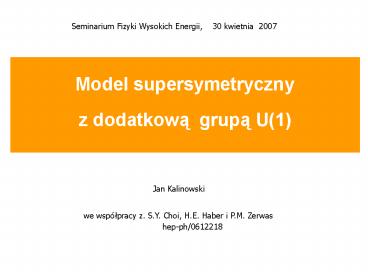Model supersymetryczny z dodatkowa grupa U(1) - PowerPoint PPT Presentation
Title:
Model supersymetryczny z dodatkowa grupa U(1)
Description:
Two iso-doublets Hu , Hd and one scalar S. l. After spontaneous EW U(1)X symmetry breaking by. the doublet higgsino mass and higgsino-singlino mass terms are ... – PowerPoint PPT presentation
Number of Views:20
Avg rating:3.0/5.0
Title: Model supersymetryczny z dodatkowa grupa U(1)
1
Model supersymetryczny z dodatkowa grupa U(1)
Seminarium Fizyki Wysokich Energii, 30
kwietnia 2007
Jan Kalinowski
we wspólpracy z. S.Y. Choi, H.E. Haber i P.M.
Zerwas
hep-ph/0612218
2
Plan seminarium
- Motywacja wyjscia poza MS
- Motywacja wyjscia poza MSSM
- Model z dodatkowa symetria U(1)
- Sektor Higgsa
- Sektor neutralin
- przyklad 2x2
- Troche fenomenologii
- Podsumowanie
3
Motivation origin of mass ?
In the SM
- one Higgs doublet
- the potential
- if (why?) and
(why?) then - EWSB ltRe Ho gt v 246 GeV
- 4 dof gt 3 massive gauge bosons MW MZ
cosqW gv/2 - one physical Higgs boson m2H l v2 /2
- but d m2H L2 gt hierarchy problem
4
MSSM medication
In the MSSM the hierarchy is stabilised
- two Higgs doublets
- the superpotential
- nice feature radiative EWSB
- min. cond.
- negative Higgs searches gt little fine
tuning
- but why m EW scale? gt the m
problem
5
Beyond MSSM
- NMSSM promote to vev of some scalar
field S -
l ltSgt
Bastero-Gil, Hugonie, King, Roy, Vempati 2000
tan b 5
New term increases the Higgs mass - allows
lighter stops reducing fine tuning
- But broken Z3 symmetry gt cosmological
domain-wall problem
6
U(1) extended SUSY
- Another way to avoid axion is to promote PQ
to the U(1) gauge - symmetry
- Gauge group USSMSU(3)xSU(2)xUY(1) x UX(1)
- New scalar S and gauge B superfields
- axion eaten-up by a
massive Z gauge boson - new fermions are needed to cancel anomalies
assume heavy - USSM a LE subset of E6SSM of
King, Moretti, Nevzorov -
hep-ph/0510419
7
Kinetic term mixing
gauge kinetic term for B and B
l
can be converted to canonical form
the U(1) part of the covariant derivative gt
effective Qx charge
ll
gaugino masses
8
Higgs sector
Two iso-doublets Hu , Hd and one scalar S
l
After spontaneous EW U(1)X symmetry breaking by
the doublet higgsino mass and higgsino-singlino
mass terms are generated
l
physical Higgs bosons three neutral scalars
two charged
one neutral
pseudoscalar
9
Higgs sector
The USSM Higgs h1 mass bound
l
NMSSM USSM
hep-ph/0510419, hep-ph/0511256
10
Neutralino sector
In the
basis, the neutralino mass matrix
where
and Higgs U(1)x charges
11
Diagonalizing M6
For small mixing between
and
- diagonalize first 4x4
- and 2x2 blocks
- perform block-diagonalization
- eigenvalues only shifted
where
12
How to solve for neutralino masses
- The neutralino mass term in the Lagrangian
Original fields Physical fields
where we require
Mathematically this is the Takagi diagonalization
of a general complex symmetric matrix (singular
value decomposition)
13
Takagi diagonalization
We want to solve (to simplify notation
)
- Physical masses are not eigenvalues they are
singular values and - in general cannot be found by a similarity
transformation.
To compute singular values
but U can be found this way only in some
particular cases
14
Takagi diagonalization
- Example
Singular value 1 is doubly-degenerate
1, i.e. does not specify U
But
Theorem for any complex symmetric nxn matrix
there exists a unitary matrix
such that
with real, non-negative
15
Proof
- can be rewritten as
Denoting k-th kolumn of U by we have
Any non-degenerate gt unique
up to a sign
(if 0, up to a phase)
Any degenerate gt invariant
subspace
take any orthonormal set of
16
By construction
- Algorithm for constructing U rewrite
as
can be diagonalized by an orthogonal
transformation
If is eigenvalue with eigenvector
, then
is eigenvalue with eigenvector
Therefore has equal number of
positive and negative eigenvalues and
even number of zero eigenvalues.
Recipe for constructing U
1) take eigenvectors
corresponding to positive 2) for
m0, are linearly dependent
17
Example
- Consider
The eigenvalues of M are degenerate and zero, and
M has only one eigenvector (1, i ).
Thus M cannot be diagonalized by a similarity
transformation.
But M has two non-degenerate singular values 0
and 2 since
Solving we find
check
18
Neutralino sector of U(1) extended SUSY
In the
basis, the neutralino mass matrix
where
and Higgs U(1)x charges
19
Real symmetric M6 can always be diagonalized
For small mixing between
and
- diagonalize first 4x4
- and 2x2 blocks
the diagonal elements can be of
both signs
- perform block-diagonalization mixing between
MSSM and new states
important if
20
Illustrative example
Evolution of the neutralino mass spectrum as a
function of
We take a scenario with
At M10, the 4 and 5 states have negative
eigenvalues
21
Neutralino production in ee-
l
via s-channel Z, Z and t-,u-channel selectron
Z exchange
Z, Z gt mass eigenstates Z1, Z2 with mixing
angle
l
selectron exchange
22
Neutralino production in ee-
in our scenario
The presence of 1 TeV Z2 strongly affects cross
sections e.g. for M10
Ecm800 GeV
although masses of are as in MSSM
23
Neutralino decays
Phenomenology changes significantly only
selected examples
- Cascade decays - c.f. LHC celebrated case
- also possible
but
24
Neutralino decays
- Radiative decays - important in cross-over
zones
e.g. near M12.6 TeV 4-5 zone
25
Summary
- USSM a well motivated and interesting scenario
- new states scalar Higgs, Z and two neutralinos
- Here exploratory studies of the USSM neutralino
sector
- neutralino sector quite complicated
- in a weakly coupled regime under good
theoretical control - production and decay processes analysed
- phenomenology at ee- and LHC quite different
- a systematic survey needs more detailed analyses
- cosmological implications gt work in progress































